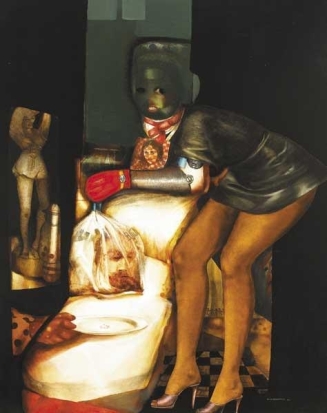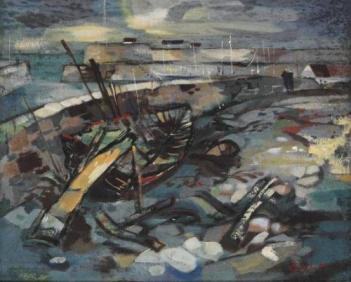
Contemporary Irish abstract landscape artist and genre scene painter John Shinnors was born in Limerick in 1950. He studied drawing and fine art painting at the Limerick School of Art and Design, and during his career has enjoyed regular solo exhibitions throughout Ireland as well as a wide range of group exhibitions. He is a member of Aosdana.
As a painter, John Shinnors is primarily a landscape artist whose focus has become increasingly abstract. Typically, he creates several preliminary watercolour studies before executing his large scale oil painting works, usually on stretched linen or cotton. His paintings, which also include interior scenes, exhibit rich chiaroscuro qualities and dramatic contrasts between light and dark.
John Shinnors’ artworks have appeared in one-man exhibitions in many galleries, including: Goodwin’s Gallery, Limerick (1978); Belltable Arts Centre, Limerick (1984); Taylor Galleries, Dublin (1998); Taylor Galleries, Dublin (2000);Crawford Art Gallery, Cork, (Travelling) (2003); The Hunt Museum, Limerick (2003); The Hunt Museum, Limerick (2004); Taylor Galleries, Dublin (2004); Crawford Municipal Art Gallery, Cork (2005); Vangard Gallery, Co. Cork (2003). In addition he has shown at numerous Royal Hibernian Academy (RHA) and Oireachtas shows.

John Shinnors’ work is represented in many public and private collections such as: Arts Council of Ireland; National Self Portrait Collection, University of Limerick; Office of Public Works; AIB (Allied Irish Banks); Ulster Museum, Belfast; Limerick City Gallery of Art (includes National Collection of Contemporary Drawing). He was the subject of the RTÉ1 documentary “Split Image John Shinnors”. He is also involved in the promotion of the arts through the Shinnors Scholarship. He lives and works in Limerick.
The highest price paid at auction for a painting by John Shinnors was recorded in 2008, when his work, entitled Estuary Forms – Limerick, was sold at Morgan O’Driscoll, in Co Cork, for €70,000.

 The Irish landscape artist Sean McSweeney, one of Ireland’s leading painters, was born in Dublin in 1935. Despite not attending art college or taking any classes in painting, he began exhibiting his pictures regularly in the 1960s, in the Irish Exhibition of Living Art and the Oireachtas. McSweeney has also had five one-man shows at the Dawson Gallery in Dublin (from 1965 until 1977), ten solo shows at the Taylor Galleries in Dublin, and numerous others at the Kenny Gallery in Galway, Vanguard Gallery in Cork and at the Fenderesky Gallery, Belfast.
The Irish landscape artist Sean McSweeney, one of Ireland’s leading painters, was born in Dublin in 1935. Despite not attending art college or taking any classes in painting, he began exhibiting his pictures regularly in the 1960s, in the Irish Exhibition of Living Art and the Oireachtas. McSweeney has also had five one-man shows at the Dawson Gallery in Dublin (from 1965 until 1977), ten solo shows at the Taylor Galleries in Dublin, and numerous others at the Kenny Gallery in Galway, Vanguard Gallery in Cork and at the Fenderesky Gallery, Belfast. Sean McSweeney’s landscape painting focuses on the phenomenon of the bog pool – deep rectangular incisions in the surface of the bog that are caused by the practice of harvesting turf – and the rugged Sligo coastline. He lives and works in Ballyconnell, Sligo, from where most of his artistic inspiration derives.
Sean McSweeney’s landscape painting focuses on the phenomenon of the bog pool – deep rectangular incisions in the surface of the bog that are caused by the practice of harvesting turf – and the rugged Sligo coastline. He lives and works in Ballyconnell, Sligo, from where most of his artistic inspiration derives. One of Ireland’s foremost landscape artists and still-life painters, George Campbell was born in County Wicklow and received his schooling in Dublin. His mother was the noted artist Gretta Bowen. George Campbell started painting in Belfast in 1941, partly as a reaction to the wartime bombing of the city. He first exhibited in 1944, alongside his friend Gerard Dillon, with whom he shared painting trips to Connemara. He first showed at the Royal Hibernian Academy (RHA) in 1948, in company with Dillon and Daniel O’Neill, and continued to show at the RHA over the next 30 years.
One of Ireland’s foremost landscape artists and still-life painters, George Campbell was born in County Wicklow and received his schooling in Dublin. His mother was the noted artist Gretta Bowen. George Campbell started painting in Belfast in 1941, partly as a reaction to the wartime bombing of the city. He first exhibited in 1944, alongside his friend Gerard Dillon, with whom he shared painting trips to Connemara. He first showed at the Royal Hibernian Academy (RHA) in 1948, in company with Dillon and Daniel O’Neill, and continued to show at the RHA over the next 30 years. Campbell’s paintings appeared in many exhibitions during his lifetime. He had his first showing at Belfast’s Mol Gallery in 1944, then in 1946 he exhibited at Waddington Galleries in Dublin – the first event in a long association with the art dealer Victor Waddington. His artworks also showed at the Ritchie Hendriks Gallery, Dublin, the Tom Caldwell Gallery, and at the IELA, the Oireachtas, and the water Colour Society of Ireland (WCSI). The Northern Irish Council for the Encouragement of Music and the Arts (CEMA) sponsored a number of solo exhibitions for Campbell in 1949, 1952 and 1960, being then replaced by the Arts Council of Northern Ireland for one-man shows in 1966 and 1972. George Campbell’s pictures are represented in most major public and private Irish collections of art.
Campbell’s paintings appeared in many exhibitions during his lifetime. He had his first showing at Belfast’s Mol Gallery in 1944, then in 1946 he exhibited at Waddington Galleries in Dublin – the first event in a long association with the art dealer Victor Waddington. His artworks also showed at the Ritchie Hendriks Gallery, Dublin, the Tom Caldwell Gallery, and at the IELA, the Oireachtas, and the water Colour Society of Ireland (WCSI). The Northern Irish Council for the Encouragement of Music and the Arts (CEMA) sponsored a number of solo exhibitions for Campbell in 1949, 1952 and 1960, being then replaced by the Arts Council of Northern Ireland for one-man shows in 1966 and 1972. George Campbell’s pictures are represented in most major public and private Irish collections of art.